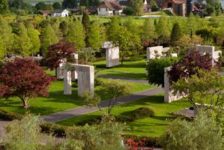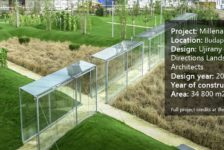“The earth has music for those who listen.” — William Shakespeare
In our fast-paced, urbanized world, where the constant hum of city life often drowns out the subtle symphony of nature, finding ways to integrate human and natural environments is increasingly crucial. Businesses are catching on – ForestLive.com, SoundsRight.earth, WeBelongHere.world, and suggest an untapped niche for the field of Landscape Architecture. Soundscape Ecology stands tall in the pursuit of radical synergy between human-made and nature-grown environments, incorporating music and acoustic design principles into landscape architecture. This innovative practice promises to enhance urban spaces, improve human well-being, and support ecological health by mitigating an increasing divide between human activities and the natural world.
The Challenge of Urban Noise
Recent research highlights the profound impact of urban noise on health and well-being. A study by McAlexander, Gershon, and Neitzel (2015) underscores the pervasive issue of street-level noise in cities, linking it to increased personal exposure and health risks. This research, along with recent developments such as the introduction of noise cameras in New York City (The Guardian, 2023), emphasizes the need for effective solutions to manage urban noise.
In this context, integrating acoustic design principles into landscape architecture offers a novel solution. By leveraging cymatics—the study of sound-induced patterns in physical matter—landscape architects can create environments that harmonize with natural soundscapes, potentially mitigating the negative effects of urban noise and enhancing overall quality of life.
The Impact of Noise on Health
Urban noise has long been recognized as a significant environmental stressor. According to McAlexander et al. (2015), street-level noise contributes to personal exposure and adverse health effects, including stress and cardiovascular issues. The study highlights the need for urban planning strategies that address noise pollution and promote healthier environments.
Recent advances in technology, such as noise cameras, are beginning to address these challenges. The Guardian (2023) reports that New York City has implemented noise cameras to monitor and reduce excessive noise levels, reflecting a growing recognition of the impact of noise pollution on urban health. This development aligns with the need for innovative design approaches that incorporate acoustic principles to create more harmonious urban environments.
Acoustic Design Principles in Landscape Architecture
Integrating acoustic design into landscape architecture involves creating environments that align with and enhance natural soundscapes. This approach not only improves aesthetic and sensory experiences but also addresses the challenges of urban noise pollution. Key findings from recent studies support this integration:
Enhancing Well-being: The research published in ScienceDirect (2024) highlights the positive effects of natural soundscapes on human well-being. Environments designed to reflect natural sound patterns can reduce stress, improve mental health, and foster a sense of tranquility. Acoustic design principles can thus be used to create spaces that mitigate the effects of urban noise and promote well-being.
Supporting Biodiversity: Effective acoustic design can also support urban biodiversity. The study from the International Journal of Advances in Science and Engineering Research (IJANSER) (2024) emphasizes the role of sound in attracting and sustaining wildlife in urban areas. By designing landscapes that mimic natural soundscapes, architects can create environments that enhance habitat connectivity and support diverse species.
Case Studies: Innovations in Acoustic Design
Several projects exemplify the successful integration of acoustic design in landscape architecture, drawing inspiration from art, music, and dance to create harmonious urban spaces.
- The High Line, New York: This elevated park integrates soundscapes that complement both urban and natural environments, creating a harmonious space that bridges human and natural systems. The design incorporates elements that resonate with natural rhythms, enhancing both aesthetic appeal and ecological health.
- The Eden Project, UK: Known for its biomes and diverse plant species, the Eden Project also integrates acoustic design principles. The project’s design enhances natural soundscapes, supporting human enjoyment and contributing to overall ecological health.
- The Artful Garden, Nilsen Landscape Design: Drawing inspiration from art, music, and dance, this garden design incorporates elements that create a multisensory experience. According to Nilsen Landscape Design (2023), the use of sound as a design element can enhance the emotional and sensory connection between people and their environment, promoting a sense of tranquility and well-being.
- Designing the Urban Soundscape, The Nature of Cities: This project emphasizes the importance of considering sound in urban design. By incorporating natural soundscapes into city planning, designers can create environments that reduce noise pollution and enhance the quality of urban life (The Nature of Cities, 2013).
- Ode to Techno Club, Bureau A: In Zurich, Bureau A designed a space inspired by techno music, integrating sound and architecture in a way that enhances the sensory experience. This project demonstrates how sound can be a powerful design tool, influencing both the aesthetic and functional aspects of a space (Metalocus, 2023).
Challenges and Future Directions
While integrating acoustic design into landscape architecture offers exciting possibilities, several challenges must be addressed:
Balancing Needs: Designing spaces that meet both human and ecological needs requires careful planning. Architects must ensure that acoustic elements enhance rather than disrupt natural habitats and do not contribute to noise pollution.
Technical Limitations: Implementing acoustic design principles involves overcoming technical challenges, such as managing noise levels and ensuring effective soundscapes. Continued research and innovation are needed to address these challenges and improve design practices.
Policy and Regulation: Beyond innovative design, policy plays a crucial role in managing urban noise. Effective zoning laws, noise regulations, and enforcement mechanisms are essential to create environments that support both human health and ecological integrity. Policies that address issues such as helicopter noise in NYC, vehicles exceeding safe decibel levels, and the impact of popular landscapes are critical components of a comprehensive approach to urban noise management.
Public Awareness and Engagement: Raising public awareness about the impact of noise pollution and the benefits of acoustic design is essential. Community engagement in the planning and design process can help ensure that urban spaces meet the needs of residents and support ecological health. Educational campaigns and participatory design workshops can empower communities to advocate for healthier soundscapes.
Technological Innovations: Advances in technology offer new tools for managing urban noise and enhancing acoustic design. From noise cameras to sound-absorbing materials, innovative solutions can help mitigate the impact of noise pollution and create more harmonious environments. Integrating these technologies into landscape architecture requires ongoing research and collaboration across disciplines.
Looking Ahead: The Future of Acoustic Landscape Architecture
The integration of music and acoustic design principles into landscape architecture holds great promise for the future. Alongside the continued deployment and expansion of nature-based solutions, advances in technology and design methods will continue to open new possibilities for creating urban spaces that are both aesthetically pleasing and ecologically regenerative and sustainable. Future projects will likely explore more sophisticated ways to harmonize human and natural systems, enhancing both human experiences and ecological functions.
A Harmonious Future
The integration of music and acoustic design principles into landscape architecture represents a transformative approach to urban planning. By addressing the challenges of urban noise and supporting ecological health, this practice offers a pathway to more harmonious and sustainable urban environments. As we move forward, embracing these innovative practices can lead to spaces that resonate with the rhythms of life itself, enhancing our well-being and fostering a deeper connection with the natural world.
As Shakespeare wisely noted, “The earth has music for those who listen.” It’s time we tune in and harmonize our urban landscapes with the natural world. They have far exceeded a public health hazard. The future of landscape architecture lies not just in creating beautiful spaces but in crafting environments that ‘resonate’ with the natural rhythms of life.
—
LEAD IMAGE: Created using Adobe Firefly by Blair Guppy










